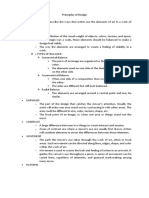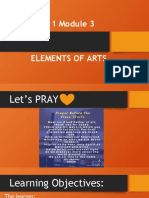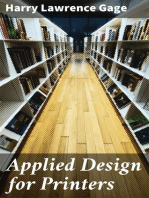0 ratings0% found this document useful (0 votes)
18 viewsReviewer For A&h
Reviewer For A&h
Uploaded by
Ninon NinonThe document discusses the elements and principles of art. It defines line, color, value, shape, form, space, and texture as the key elements used to create art. It then explains the principles of balance, rhythm, emphasis, proportion, and scale that are used to organize the elements. Symmetrical and asymmetrical balance are described as well as different types of rhythm like regular, graduated, and random.
Copyright:
© All Rights Reserved
Available Formats
Download as DOCX, PDF, TXT or read online from Scribd
Reviewer For A&h
Reviewer For A&h
Uploaded by
Ninon Ninon0 ratings0% found this document useful (0 votes)
18 views2 pagesThe document discusses the elements and principles of art. It defines line, color, value, shape, form, space, and texture as the key elements used to create art. It then explains the principles of balance, rhythm, emphasis, proportion, and scale that are used to organize the elements. Symmetrical and asymmetrical balance are described as well as different types of rhythm like regular, graduated, and random.
Original Title
REVIEWER FOR A&H
Copyright
© © All Rights Reserved
Available Formats
DOCX, PDF, TXT or read online from Scribd
Share this document
Did you find this document useful?
Is this content inappropriate?
The document discusses the elements and principles of art. It defines line, color, value, shape, form, space, and texture as the key elements used to create art. It then explains the principles of balance, rhythm, emphasis, proportion, and scale that are used to organize the elements. Symmetrical and asymmetrical balance are described as well as different types of rhythm like regular, graduated, and random.
Copyright:
© All Rights Reserved
Available Formats
Download as DOCX, PDF, TXT or read online from Scribd
Download as docx, pdf, or txt
0 ratings0% found this document useful (0 votes)
18 views2 pagesReviewer For A&h
Reviewer For A&h
Uploaded by
Ninon NinonThe document discusses the elements and principles of art. It defines line, color, value, shape, form, space, and texture as the key elements used to create art. It then explains the principles of balance, rhythm, emphasis, proportion, and scale that are used to organize the elements. Symmetrical and asymmetrical balance are described as well as different types of rhythm like regular, graduated, and random.
Copyright:
© All Rights Reserved
Available Formats
Download as DOCX, PDF, TXT or read online from Scribd
Download as docx, pdf, or txt
You are on page 1of 2
REVIEWER FOR A&H 1.
Symmetrical Balance - The parts of an
image are organized so that one side
ELEMENTS AND PRINCIPLE OF ARTS
mirrors the other.
THE ELEMENTS OF ART 2. Asymmetrical Balance - When one side
of a composition does not reflect the
The Elements of Art The building blocks or design of the other.
ingredients of art.
EMPHASIS - The focal point of an image, or
LINE - A mark with length and direction. when one area or thing stand out the most.
A continuous mark made on a surface CONTRAST - A large difference between two
by a moving point. things to create interest and tension.
COLOR - Consists of Hue (another word for RHYTHM and MOVEMENT - A regular repetition
color), Intensity (brightness) and Value of elements to produce the look and feel of
(lightness or darkness). movement.
VALUE - The lightness or darkness of a color. PATTERN and REPITITION - Repetition of a
SHAPE - An enclosed area defined and design.
determined by other art elements; 2- UNITY - When all the elements and principles
dimensional. work together to create a pleasing image.
FORM - A 3-dimensional object; or something in VARIETY - The use of differences and change to
a 2-dimensional artwork that appears to be 3- increase the visual interest of the work.
dimensional.
PROPORTION - The comparative relationship of
For example, a triangle, which is 2- one part to another with respect to size,
dimensional, is a shape, but a pyramid, which is quantity, or degree; SCALE.
3-dimensional, is a form.
PRINCIPLES OF DESIGN
SPACE - The distance or area between, around,
above, below, or within things. BALANCE – Parts of the design are equally
distributed to create a sense of stability. Both
Positive (filled with something) and physical and visual balance exist.
Negative (empty areas). Foreground, Middle
ground, and Background (creates DEPTH). Types:
TEXTURE - The surface quality or “feel” of an Symmetrical or informal balance
object, its smoothness, roughness, softness, etc. The elements within the design are
Textures may be actual or implied. identical in relation to a centerline or
axis.
THE PRINCIPLES OF ART
Asymmetrical or formal balance
What we use to organize the Elements of Art, or Parts of the design are not identical but
the tools to make art. are equal in visual weight.
Radial balance
BALANCE - The way the elements are arranged Design elements radiate outward from
to create a feeling of stability in a work. the center.
Vertical balance
The top and bottom part are equal.
Horizontal balance
The part on the left and right sides are
equal.
RHYTHM
Repeated use of line, shape, color, texture, or
pattern
Regular rhythm
An element is repeated at the same
repetition/interval each time.
Graduated rhythm
Random rhythm
The beats of the element are random or
at irregular intervals.
Gradated rhythm
The repeated element is identical with
the exception of one detail increasing or
decreasing gradually with each
repetition.
EMPHASIS
The feature in a design that attracts
one’s eye – the focal point
Emphasis can be achieved through size,
placement, shape, color, and/or use of
lines.
PROPORTION AND SCALE
Comparative relationships between
elements in a design with respect to
size.
3:5 ratio is known as the Golden Mean
You might also like
- Testbank For Database Systems Design, Implementation, & Management - Libgen - LiDocument136 pagesTestbank For Database Systems Design, Implementation, & Management - Libgen - Limoaaz LT100% (1)
- Principles of Design PDFDocument1 pagePrinciples of Design PDFArcelli Surigao Perfectua UsogNo ratings yet
- Accellos - Guide - WebDispatch - ManualDocument348 pagesAccellos - Guide - WebDispatch - Manualcaplusinc100% (2)
- Principles of DesignDocument2 pagesPrinciples of Designjane barquinNo ratings yet
- Principles of DesignDocument23 pagesPrinciples of DesignArul Mozhi100% (1)
- The Elements and Principles of ArtDocument37 pagesThe Elements and Principles of ArtPrince Leonard DomingoNo ratings yet
- Basic Design PrinciplesDocument1 pageBasic Design PrinciplesDiana DuranteNo ratings yet
- Arts 7 Quarter 1 Module 3 AND 4Document25 pagesArts 7 Quarter 1 Module 3 AND 4Art Albay100% (2)
- Elements and Principles of ArtDocument36 pagesElements and Principles of ArtCharmaine JonesNo ratings yet
- Elements Principles: of andDocument36 pagesElements Principles: of andSHIRLEY M. CLARIDADESNo ratings yet
- Line Shape Color Value Texture Space Form Balance Variety Movement Contrast Emphasis Proportion UnityDocument50 pagesLine Shape Color Value Texture Space Form Balance Variety Movement Contrast Emphasis Proportion UnityJaivikas ChoudharyNo ratings yet
- Principles Elements-EckertDocument14 pagesPrinciples Elements-Eckertapi-487437900No ratings yet
- Arta Finals TransesDocument1 pageArta Finals TranseswooziwaegNo ratings yet
- Principles of DesignDocument24 pagesPrinciples of DesignParah ApostolNo ratings yet
- The Principles of Design OrganisationDocument23 pagesThe Principles of Design OrganisationKENNETH S. MAHINGGIL MoeNo ratings yet
- Elements and Principles of DesignDocument18 pagesElements and Principles of DesignDessa Gerremy P. VelezNo ratings yet
- ELEMENTS OF ART-WPS OfficeDocument3 pagesELEMENTS OF ART-WPS OfficelifeyneedyNo ratings yet
- Interior Design Assignment 1: BY, S. DivyaDocument11 pagesInterior Design Assignment 1: BY, S. DivyaSaawan ShaikNo ratings yet
- Elements of Arts and Principles of DesignDocument10 pagesElements of Arts and Principles of DesignSharlette SaulNo ratings yet
- Updated Principles of DesignDocument49 pagesUpdated Principles of DesignsonypspaoloNo ratings yet
- Elements of Art 1Document21 pagesElements of Art 1Fredrex SalacNo ratings yet
- Lesson 4Document21 pagesLesson 4acechristianmodequillo12No ratings yet
- Design Elements PrinciplesDocument16 pagesDesign Elements PrinciplesLevy SorianoNo ratings yet
- Elements & PrinciplesDocument17 pagesElements & Principlescaro sturgesNo ratings yet
- Lesson - 8 - Elements-And-Principles-Of-ArtDocument87 pagesLesson - 8 - Elements-And-Principles-Of-ArtNiel Adrian C. ContrerasNo ratings yet
- Basic Principles and Elements of ArtDocument43 pagesBasic Principles and Elements of ArtAbiy AndualemNo ratings yet
- Gec 6 Unit 4Document28 pagesGec 6 Unit 4ladyannurotNo ratings yet
- Principles of DesignDocument3 pagesPrinciples of Designpamela.luna041605No ratings yet
- The Building Blocks of Making ArtDocument2 pagesThe Building Blocks of Making ArtSarina DiakosNo ratings yet
- Week 5 REVIEWER Elements and Principles of ArtDocument6 pagesWeek 5 REVIEWER Elements and Principles of ArtJamilla Rose AndalNo ratings yet
- Ar 114 ResearchDocument3 pagesAr 114 ResearchAngelic BasiyaNo ratings yet
- Principles of DesignRevDocument3 pagesPrinciples of DesignRevJessa Mae BebosoNo ratings yet
- Rva 4Document33 pagesRva 4Jacob Andrew DuronNo ratings yet
- 202004061919580450balram Sharma FA Elements of ArtDocument2 pages202004061919580450balram Sharma FA Elements of ArtManav DarjiNo ratings yet
- Art Elements: LINE - Has A Single Dimension, Joining Two Points. It Has Length andDocument3 pagesArt Elements: LINE - Has A Single Dimension, Joining Two Points. It Has Length andCaesy Ann BinucyawanNo ratings yet
- Basic Principles of Graphics and LayoutDocument23 pagesBasic Principles of Graphics and LayoutTeddyCatimbangNo ratings yet
- LEC 1 Principles of DesignDocument2 pagesLEC 1 Principles of DesignLeah Arnee AlejandroNo ratings yet
- Elementsand Principles CompositionDocument2 pagesElementsand Principles CompositionitszekomNo ratings yet
- Principles and Elements of DesignDocument17 pagesPrinciples and Elements of DesignJomar OrtegaNo ratings yet
- Photography Content Using Elements and Principles ArtDocument32 pagesPhotography Content Using Elements and Principles ArtbronwynNo ratings yet
- Philippine Contemporary Arts: CPAR112Document62 pagesPhilippine Contemporary Arts: CPAR112CaladhielNo ratings yet
- Arts 7Document30 pagesArts 7ivan tagiobonNo ratings yet
- Principles of ArtDocument2 pagesPrinciples of ArtbocajrrNo ratings yet
- Elements of Art and Principles of ArtDocument36 pagesElements of Art and Principles of ArtElieNo ratings yet
- Elements and Principles of ArtDocument21 pagesElements and Principles of ArtjireynnNo ratings yet
- LESSON 4 Elements and Principle MidtermDocument48 pagesLESSON 4 Elements and Principle MidtermJinzel Kaye CristobalNo ratings yet
- My PPT On Visual ArtsDocument21 pagesMy PPT On Visual ArtsAgustines, Marie Char C.No ratings yet
- Principles of DesignDocument20 pagesPrinciples of DesignCarmela LucilleNo ratings yet
- Lesson 7. Elements and Principles of ArtDocument83 pagesLesson 7. Elements and Principles of ArtSophiaEllaineYanggatLopez100% (7)
- Elements and Principles of ArtsDocument10 pagesElements and Principles of ArtsEllah Faye Del RosarioNo ratings yet
- The Principles of Art Design 150823084224 Lva1 App6891Document55 pagesThe Principles of Art Design 150823084224 Lva1 App6891kathleenNo ratings yet
- Elements of DesignDocument14 pagesElements of DesignRemyaNo ratings yet
- ART APP Reviewer - Lesson 5Document2 pagesART APP Reviewer - Lesson 5ArcCoronaNo ratings yet
- New Principles of Design Study GuideDocument5 pagesNew Principles of Design Study GuideerikalizeeNo ratings yet
- Elements and PrinciplesDocument37 pagesElements and Principlesapi-262378299No ratings yet
- Principles of DesignSemi FinalDocument45 pagesPrinciples of DesignSemi FinalerasquinglydelNo ratings yet
- Cpar Q2 ReviewerDocument2 pagesCpar Q2 ReviewerJaslor LavinaNo ratings yet
- Elements of ArtsDocument1 pageElements of ArtsCristineNo ratings yet
- Principle of Art and DesignDocument16 pagesPrinciple of Art and DesignCrystal MercadoNo ratings yet
- Applied Design for Printers A Handbook of the Principles of Arrangement, with Brief Comment on the Periods of Design Which Have Most Strongly Influenced Printing Typographic Technical Series for Apprentices #43From EverandApplied Design for Printers A Handbook of the Principles of Arrangement, with Brief Comment on the Periods of Design Which Have Most Strongly Influenced Printing Typographic Technical Series for Apprentices #43No ratings yet
- Application Tutorial: STL Machining 3-Axis Roughing and Finishing (HSR/HSM) and Sim. 5-Axis FinishingDocument61 pagesApplication Tutorial: STL Machining 3-Axis Roughing and Finishing (HSR/HSM) and Sim. 5-Axis FinishingMirjana EricNo ratings yet
- Amp Assignment 1Document7 pagesAmp Assignment 1Akash SawantNo ratings yet
- Compatible Motherboards - I5-12400Document9 pagesCompatible Motherboards - I5-12400camilo vargasNo ratings yet
- Slewing Bearing Slewing Ring Slewing Gear Swing CircleDocument1 pageSlewing Bearing Slewing Ring Slewing Gear Swing Circlezczc32z5No ratings yet
- Bijou CovidDocument2 pagesBijou CovidDieuleveutzola in zolaniNo ratings yet
- Consolidated Report: Apex CentralDocument8 pagesConsolidated Report: Apex CentralEnrique BaumannNo ratings yet
- Game LogDocument21 pagesGame LogMarko MarkovicNo ratings yet
- Digital Electronics Lab-3Document150 pagesDigital Electronics Lab-3hajera.mubeen2006No ratings yet
- Software InstallationDocument15 pagesSoftware InstallationTarık Bercan SarıNo ratings yet
- HindisongNotes - TAB For Song Pal Pal Har Pal Lage Raho Munna BhaiDocument3 pagesHindisongNotes - TAB For Song Pal Pal Har Pal Lage Raho Munna BhaiManish MaithaniNo ratings yet
- Paper PresentationDocument27 pagesPaper PresentationShaik AkramNo ratings yet
- CBCHB ManualDocument111 pagesCBCHB Manualpmiklos2No ratings yet
- ASR901-10G Datasheet PDFDocument14 pagesASR901-10G Datasheet PDFVasyaNo ratings yet
- Assessment 2 (Part A) Individual Lab Assignment: Universiti Teknologi MARA Cawangan PerlisDocument5 pagesAssessment 2 (Part A) Individual Lab Assignment: Universiti Teknologi MARA Cawangan PerlisAffiq HakimNo ratings yet
- Release Notes, UNICORN Start 1.3 - 29695178AADocument6 pagesRelease Notes, UNICORN Start 1.3 - 29695178AAsamuelNo ratings yet
- Python Project ReportDocument15 pagesPython Project ReportSakshi Sonavane100% (1)
- Accurate - Design - Simulations - White Paper PDFDocument18 pagesAccurate - Design - Simulations - White Paper PDFsamar kadamNo ratings yet
- KMSpico v5.2.1 Instructions InfoDocument3 pagesKMSpico v5.2.1 Instructions InfoRadwan AhmedNo ratings yet
- 5#application of Computers in Hospital PharmacyDocument14 pages5#application of Computers in Hospital PharmacySamra BatoolNo ratings yet
- Queueing Theory - SlidesDocument40 pagesQueueing Theory - Slidesanjanadas2701No ratings yet
- Installing DAO350.dll in Win7 64 Bit v1.1Document14 pagesInstalling DAO350.dll in Win7 64 Bit v1.1Ivan MajikNo ratings yet
- Function: List of VBA Functions and Their UsageDocument4 pagesFunction: List of VBA Functions and Their Usagemanglanihitesh5248No ratings yet
- DP 3 2 PracticeDocument7 pagesDP 3 2 PracticeJessica IreneNo ratings yet
- TS ICET User Guide-2023Document25 pagesTS ICET User Guide-2023Nody Nody1No ratings yet
- Quaternion ConradDocument19 pagesQuaternion ConradWalter ariel BayaNo ratings yet
- Component Replacement - 009 PDFDocument11 pagesComponent Replacement - 009 PDFfafeafafafafNo ratings yet
- Crash LogDocument6 pagesCrash Logbrawlstarswiki1No ratings yet
- MULTIPLE CHOICE. Choose The One Alternative That Best Completes The Statement or Answers The Question. AddDocument3 pagesMULTIPLE CHOICE. Choose The One Alternative That Best Completes The Statement or Answers The Question. AddRakesh BhatNo ratings yet

























































































